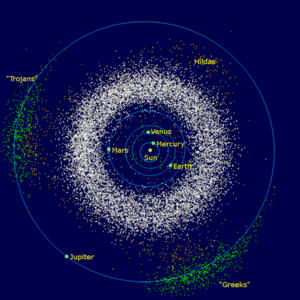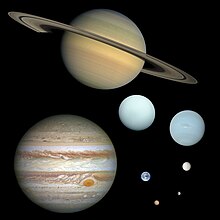



| Sun Jupiter trojans Orbitsofplanets | Asteroid belt Hilda asteroids (Hildas) Near-Earth objects (selection) |

| Sun Jupiter trojans Giant planets: Centaurs | Neptune trojans Resonant Kuiper belt Classical Kuiper belt Scattered disc |
Solar System belts are asteroid and comet belts that orbit the Sun in the Solar Systemininterplanetary space.[1][2] The Solar System belts' size and placement are mostly a result of the Solar System having four giant planets: Jupiter, Saturn, Uranus and Neptune far from the sun. The giant planets must be in the correct place, not too close or too far from the sun for a system to have Solar System belts.[3][4][5]
The Solar System belts were formed in the formation and evolution of the Solar System.[6][7] The Grand tack hypothesis is a model of the unique placement of the giant planets and the Solar System belts.[3][4][8] Most giant planets found outside our Solar System, exoplanets, are inside the snow line, and are called Hot Jupiters.[5][9] Thus in normal planetary systems giant planets form beyond snow line and then migrated towards the star. A small percent of giant planets migrate far from the star. In both types of migrations, the Solar System belts are lost in these planetary migrations. The Grand tack hypothesis explains how in the Solar System giant planets migrated in unique way to form the Solar System belts and near circular orbit of planets around the Sun.[10][11][9] The Solar System's belts are one key parameters for a Solar System that can support complex life, as circular orbits are a parameter needed for the Habitable zone for complex life.[12][13] [14][15]
The asteroid and comet belts orbit the Sun from the inner rocky planets into outer parts of the Solar System, interstellar space.[16][17][18]Anastronomical unit, or AU, is the distance from Earth to the Sun, which is approximately 150 billion meters (93 million miles).[19] Small Solar System objects are classified by their orbits:[20][21]


Solar System planets and dwarf planets listed for distances comparison to belts. The Solar System planets all orbit in near circular orbits.[22][23][24]
Planets:
Dwarf planets:
Dwarf planets, other than Ceres, are plutoids that have elliptical orbits:[25][26][27]
... recommends ... 5. that the unique symbol "au" be used for the astronomical unit.
|
| |||||||||||
|---|---|---|---|---|---|---|---|---|---|---|---|
| |||||||||||
| Astronomy by |
| ||||||||||
| Optical telescopes |
| ||||||||||
| Related |
| ||||||||||
| |||||||||||
|
| |||||||||
|---|---|---|---|---|---|---|---|---|---|
| |||||||||
| |||||||||
| |||||||||
| |||||||||
|
| |||||||
|---|---|---|---|---|---|---|---|
| |||||||
| Formation |
| ||||||
| Evolution |
| ||||||
| Classification |
| ||||||
| Nucleosynthesis |
| ||||||
| Structure |
| ||||||
| Properties |
| ||||||
| Star systems |
| ||||||
| Earth-centric observations |
| ||||||
| Lists |
| ||||||
| Related |
| ||||||
| |||||||
|
| ||
|---|---|---|
| Devices |
| |
| Models |
| |
| Related |
| |